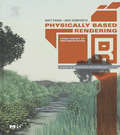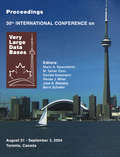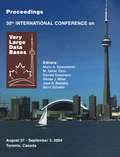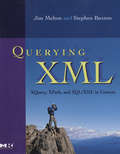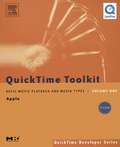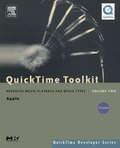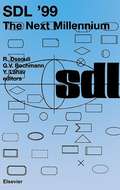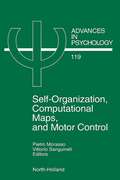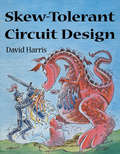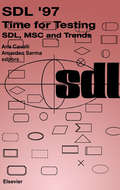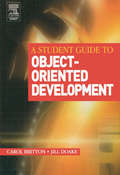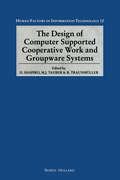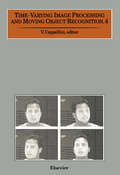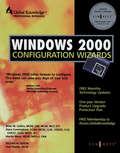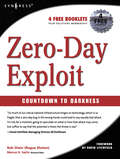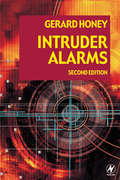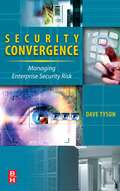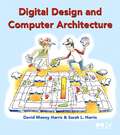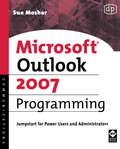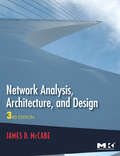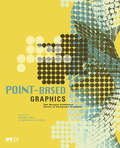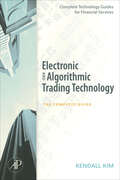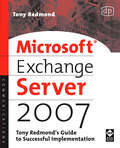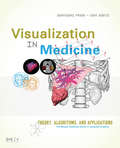- Table View
- List View
Physically Based Rendering: From Theory to Implementation
by Matt Pharr Greg HumphreysRendering is a crucial component of computer graphics— the conversion of a description of a 3D scene into an image for display. Algorithms for animation, geometric modeling, and texturing all must feed their results through some sort of rendering process for the results to be visible in an image. Focusing on realistic images, physically based rendering incorporates ideas from a range of disciplines, including physics, biology, psychology, cognitive science, and mathematics. This book presents the algorithms of modern photorealistic rendering and follows step by step the creation of a complete rendering system. As each new rendering concept is introduced it is also shown implemented in code—there is no better way to understand the subtle and complex process of rendering. The code itself is highly readable, written in the literate programming style that mixes text describing the system with the code that implements it. The result is a stunning achievement in graphics education for students, professionals, and researchers.*CD-ROM with the source code for a complete rendering system for Windows, OS X, & Linux—with many examples of images created by the system throughout the 4 color text*The code and text are tightly woven together through the technique of literate programming with a unique indexing feature that lists all locations of functions, variables, and methods on the page they are first described*The most complete guide to understanding, designing, and building a rendering system
Proceedings 2003 VLDB Conference: 29th International Conference on Very Large Databases (VLDB)
by VLDBProceedings of the 29th Annual International Conference on Very Large Data Bases held in Berlin, Germany on September 9-12, 2003. Organized by the VLDB Endowment, VLDB is the premier international conference on database technology.
Proceedings 2004 VLDB Conference: The 30th International Conference on Very Large Databases (VLDB)
by VLDBProceedings of the 30th Annual International Conference on Very Large Data Bases held in Toronto, Canada on August 31 - September 3 2004. Organized by the VLDB Endowment, VLDB is the premier international conference on database technology.
Querying XML: XQuery, XPath, and SQL/XML in context (The Morgan Kaufmann Series in Data Management Systems)
by Jim Melton Stephen BuxtonXML has become the lingua franca for representing business data, for exchanging information between business partners and applications, and for adding structure–and sometimes meaning—to text-based documents. XML offers some special challenges and opportunities in the area of search: querying XML can produce very precise, fine-grained results, if you know how to express and execute those queries.For software developers and systems architects: this book teaches the most useful approaches to querying XML documents and repositories. This book will also help managers and project leaders grasp how “querying XML" fits into the larger context of querying and XML. Querying XML provides a comprehensive background from fundamental concepts (What is XML?) to data models (the Infoset, PSVI, XQuery Data Model), to APIs (querying XML from SQL or Java) and more.* Presents the concepts clearly, and demonstrates them with illustrations and examples; offers a thorough mastery of the subject area in a single book. * Provides comprehensive coverage of XML query languages, and the concepts needed to understand them completely (such as the XQuery Data Model).* Shows how to query XML documents and data using: XPath (the XML Path Language); XQuery, soon to be the new W3C Recommendation for querying XML; XQuery's companion XQueryX; and SQL, featuring the SQL/XML * Includes an extensive set of XQuery, XPath, SQL, Java, and other examples, with links to downloadable code and data samples.
QuickTime Toolkit Volume One: Basic Movie Playback and Media Types (QuickTime Developer Series)
by Tim Monroe"When QuickTime application developers get stuck, one of the first places they look for help is example code from Tim Monroe. Finally, Tim's well-crafted examples and clear descriptions are available in book form—a must-have for anyone writing applications that import, export, display, or interact with QuickTime movies." —Matthew Peterson; University of California, Berkeley; the M.I.N.D. Institute; and author of Interactive QuickTimeQuickTime Toolkit Volume One is a programmer’s introduction to QuickTime, the elegant and potent media engine used by many of Apple's industry-leading services and products (such as the iTunes music store, iMovie, and Final Cut Pro) and also used by a large number of third-party applications. This hands-on guide shows you how to harness the powerful capabilities of QuickTime for your own projects. The articles collected here from the author's highly regarded column in MacTech Magazine are packed with accessible code examples to get you quickly started developing applications that can display and create state-of-the-art digital content. This book begins by showing how to open and display QuickTime movies in a Macintosh or Windows application and progresses step by step to show you how to control movie playback and how to import and transform movies and images. QuickTime Toolkit also shows how to create movies with video data, text, time codes, sprites, and wired (interactive) elements.Part of the official QuickTime Developer Series, publishing the finest books on QuickTime in cooperation with Apple.Written in a clear, engaging style by one of Apple's premier media engineers known for his ability to make QuickTime's sophisticated technology accessible to software developersOffers many undocumented insider tips for making applications that work well in both Mac OS and Windows
QuickTime Toolkit Volume Two: Advanced Movie Playback and Media Types (QuickTime Developer Series)
by Tim Monroe"Buried inside QuickTime are a host of powerful tools for creating, delivering, and playing digital media. The official QuickTime documentation explains 'what' each API function does. But knowing what each function does isn't enough to allow a developer to take full advantage of QuickTime. QuickTime Toolkit fills in the gap—providing plenty of practical examples of 'how' to use QuickTime to perform all kinds of useful tasks. More importantly, [this book] goes beyond 'how' and into 'why' —providing readers with a deeper understanding of QuickTime and how to benefit from using it in their own products." —Peter Hoddie, cofounder of Kinoma and former QuickTime architectQuickTime Toolkit, Volume Two continues the step-by-step investigation of programming QuickTime, the elegant and powerful media engine used by many of Apple's industry-leading services and products (such as the iTunes music store, iMovie, and Final Cut Pro) and also used by a large number of third-party applications. This second collection of articles from the author's highly regarded column in MacTech Magazine builds upon the discussion of playback techniques and media types presented in the first volume to cover advanced types of QuickTime media data, including video effects, Flash tracks, and skins. It shows how to capture audio and video data, broadcast that data to remote computers, play movies full screen, and load movies asynchronously. QuickTime Toolkit Volume Two also shows how to integrate Carbon events into your Macintosh application and how to work with Macintosh resources in your Windows application.Part of the official QuickTime Developer Series, publishing the finest books on QuickTime in cooperation with Apple.Written by one of Apple's premier media engineers skilled in revealing QuickTime's sophisticated technology to programmersOffers many undocumented insider tips for making applications that work well in both Mac OS and Windows
SDL '99: The Next Millennium
by R. Dssouli G. V. Bochmann Y. LahavThis book represents the proceedings of the 9th SDL Forum which was held in Montreal, Quebec, Canada, during the week of June 21-25, 1999. The 9th SDL Forum presents papers on the past and future development of the MSC and SDL languages.The volume presents information on experience with the use of these languages in industrial development projects, on tools and techniques for using these languages in the software and hardware development process, and other aspects of these languages.
Self-Organization, Computational Maps, and Motor Control (ISSN #Volume 119)
by P.G. Morasso V. SanguinetiIn the study of the computational structure of biological/robotic sensorimotor systems, distributed models have gained center stage in recent years, with a range of issues including self-organization, non-linear dynamics, field computing etc. This multidisciplinary research area is addressed here by a multidisciplinary team of contributors, who provide a balanced set of articulated presentations which include reviews, computational models, simulation studies, psychophysical, and neurophysiological experiments.The book is divided into three parts, each characterized by a slightly different focus: in part I, the major theme concerns computational maps which typically model cortical areas, according to a view of the sensorimotor cortex as "geometric engine" and the site of "internal models" of external spaces. Part II also addresses problems of self-organization and field computing, but in a simpler computational architecture which, although lacking a specialized cortical machinery, can still behave in a very adaptive and surprising way by exploiting the interaction with the real world. Finally part III is focused on the motor control issues related to the physical properties of muscular actuators and the dynamic interactions with the world.The reader will find different approaches on controversial issues, such as the role and nature of force fields, the need for internal representations, the nature of invariant commands, the vexing question about coordinate transformations, the distinction between hierachiacal and bi-directional modelling, and the influence of muscle stiffness.
Skew-Tolerant Circuit Design (ISSN)
by David HarrisAs advances in technology and circuit design boost operating frequencies of microprocessors, DSPs and other fast chips, new design challenges continue to emerge. One of the major performance limitations in today's chip designs is clock skew, the uncertainty in arrival times between a pair of clocks. Increasing clock frequencies are forcing many engineers to rethink their timing budgets and to use skew-tolerant circuit techniques for both domino and static circuits. While senior designers have long developed their own techniques for reducing the sequencing overhead of domino circuits, this knowledge has routinely been protected as trade secret and has rarely been shared. Skew-Tolerant Circuit Design presents a systematic way of achieving the same goal and puts it in the hands of all designers. This book clearly presents skew-tolerant techniques and shows how they address the challenges of clocking, latching, and clock skew. It provides the practicing circuit designer with a clearly detailed tutorial and an insightful summary of the most recent literature on these critical clock skew issues.Synthesizes the most recent advances in skew-tolerant design in one cohesive tutorialProvides incisive instruction and advice punctuated by humorous illustrationsIncludes exercises to test understanding of key concepts and solutions to selected exercises
SDL '97: SDL, MSC and Trends
by Ana Cavalli Amardeo SarmaAs Cavalli and Sarma astutely remarked in the introduction to this volume, it is quite remarkable that SDL '97 may have the first participant younger than SDL itself. SDL '97 provides the opportunity to reflect the course SDL has taken and why it has been successful over two decades where other languages addressing the same market have failed.SDL now also has a permanent companion in MSC (Message Sequence Charts). MSC today is a language in its own right and has its areas of application both in conjunction with SDL and independently or in combination with other techniques. MSC has strong structuring concepts to specify message sequences for large systems and can be used to develop scenarios, which is extremely useful for test and design environments. The SDL Forum today really is the SDL and MSC Forum.
A Student Guide to Object-Oriented Development
by Carol Britton Jill DoakeA Student Guide to Object-Oriented Development is an introductory text that follows the software development process, from requirements capture to implementation, using an object-oriented approach. The book uses object-oriented techniques to present a practical viewpoint on developing software, providing the reader with a basic understanding of object-oriented concepts by developing the subject in an uncomplicated and easy-to-follow manner. It is based on a main worked case study for teaching purposes, plus others with password-protected answers on the web for use in coursework or exams. Readers can benefit from the authors' years of teaching experience. The book outlines standard object-oriented modelling techniques and illustrates them with a variety of examples and exercises, using UML as the modelling language and Java as the language of implementation. It adopts a simple, step by step approach to object-oriented development, and includes case studies, examples, and exercises with solutions to consolidate learning. There are 13 chapters covering a variety of topics such as sequence and collaboration diagrams; state diagrams; activity diagrams; and implementation diagrams. This book is an ideal reference for students taking undergraduate introductory/intermediate computing and information systems courses, as well as business studies courses and conversion masters' programmes.Adopts a simple, step by step approach to object-oriented developmentIncludes case studies, examples, and exercises with solutions to consolidate learningBenefit from the authors' years of teaching experience
The Design of Computer Supported Cooperative Work and Groupware Systems (ISSN #Volume 12)
by Dan Shapiro Michael Tauber Roland TraunmüllerThe phrases the information superhighway and the the information societyare on almost everyone's lips. CSCW and groupware systems are the key to bringing those phrases to life. To an extent that would scarcely have been imaginable a few years ago, the contributions in this volume speak to each other and to a broader interdisciplinary context. The areas of ethnography and design, the requirements and principles of CSCW design, CSCW languages and environments, and the evaluation of CSCW systems are brought together, to bring to light how activities in working domains are really in practice, carried out. The aim above all is to do justice to the creativity and versatility of those whose work they aim to support.
Time-Varying Image Processing and Moving Object Recognition, 4
by V. CappelliniNew digital image processing and recognition methods, implementation techniques and advanced applications (television, remote sensing, biomedicine, traffic, inspection, robotics, etc.) are presented in this volume. Novel approaches (i.e. digital filters, source coding, neural networks etc.) for solving 2-D and 3-D problems are described. Many papers focus on the motion estimation and tracking recognition of moving objects. The increasingly important field of Cultural Heritage is also covered. Some papers are more theoretical or of review nature, while others contain new implementations and applications. Generally the book presents - for the above outlined area - the state of the art (theory, implementation, applications) with future trends.This book will be of interest not only to researchers, professors and students in university departments of engineering, communications, computers and automatic control, but also to engineers and managers of industries concerned with computer vision, manufacturing, automation, robotics and quality control.
Windows 2000 Configuration Wizards
by SyngressDevelopers are used to working with Wizards, component-like products that allow them to create certain elements - like dialog buttons - quickly and easily while they are coding applications. With the launch of Windows 2000, Microsoft has announced a new set of Wizards that will help administrators and users configure and set up Windows 2000 Professional (the Windows NT 4 Workstation successor) and Windows 2000 Server (the Windows NT 4 Server successor). Windows 2000 Setup and Configuration Wizards covers all the available Wizards, with an emphasis on those new to Windows 2000. Each Wizard is broken down by dialog box, with explanations of all options and required elements so administrators will know what to be prepared with.In addition, coverage of new services that will speed configuration and set up (like the Windows Installer) will be covered. * This is the first book to focus on Wizards and Windows 2000 automated components* Network administrators and developers will save time using this book
Zero-Day Exploit: Countdown to Darkness (Cyber-Fiction)
by Rob SheinThe realistic portrayals of researching, developing, and ultimately defending the Internet from a malicious "Zero-Day" attack will appeal to every corner of the IT community. Although finctional, the numerous accounts of real events and references to real people will ring true with every member of the security community. This book will also satisfy those not on the "inside" of this community, who are fascinated by the real tactics and motives of criminal, malicous hackers and those who defent the Internet from them.* The realistic portrayals of researching, developing, and ultimately defending the Internet from a malicious "Zero-Day" attack will appeal to every corner of the IT community.* This book will entertain, educate, and enlighten the security and IT community about the world of elite security professionals who safeguard the Internet from the most dangerous cyber criminals and terrorists.* Although finctional, the numerous accounts of real events and references to real people will ring true with every member of the security community.
Closed Circuit Television: CCTV Installation, Maintenance and Operation
by Joe CieszynskiClosed Circuit Television (CCTV) surveillance is one of the fastest growing areas in the security industry. This book is an essential guide for professionals involved the installation and maintenance of CCTV systems, system design, specification and purchasing and the management of CCTV systems. Unlike most existing books on CCTV, this title is not just a discussion of security issues, but a thorough guide to the technical side of the subject - cameras and monitors, video recording, cabling and transmission, installation and maintenance.The concise, accessible text makes it for hard-pressed practitioners and students on training courses.The second edition is fully dual-standard for PAL and NTSC systems. New material in the second edition covers lighting issues and equipment, digital signal transmission, integrated CCTV / intruder alarm systems, CAT5 cabling, digital recording, video printers, ancillary equipment, and a glossary.This book is recommended by SITO (the Security Industry Training Organisation, UK) as suitable for its courses, the City and Guilds 1851 programme, and the underpinning knowledge requirement of Level 3 NVQs from SITO / C & G. Joe Cieszynski is a well known magazine writer and a contributor to the SITO distance learning materials on CCTV. He has extensive experience in the industry and as a lecturer.* Demystifies CCTV technology for installers and managers* Concise, accessible text ideal for hard-pressed practitioners and students* Fully dual-standard coverage for PAL and NTSC based systems
Intruder Alarms
by Gerard HoneyIntruder Alarms provides a definitive and fully up-to-date guide to the specification, systems design, integration, installation and maintenance of intruder alarm systems. It has been written to be the essential handbook for installation engineers and security professionals working in this rapidly expanding and developing area.The second edition includes new material on the use of remote signalling and networking and an expanded section on the integration of security systems, including real-world case studies. Information on police response policy, and the use of confirmed alarm technology has been updated, along with coverage of accreditation systems, NSI and ICON.This book has been endorsed by SITO (the UK's Security Industry Training Organisation) as a suitable text for students following the relevant SITO courses including the SITO / City & Guilds scheme 1851: Knowledge of Security and Emergency Alarm Systems.* The practical guide for installation engineers and security professionals* Essential reading for anyone responsible for the commissioning and maintenance of security alarm systems* New edition covers networking and integration issues
Security Convergence: Managing Enterprise Security Risk
by Dave TysonSecurity Convergence describes the movement in business to combine the roles of physical security and security management with network computer security measures within an organization. This is the first book to discuss the subject of security convergence, providing real-world illustrations of implementation and the cost-saving benefits that result. Security Convergence discusses security management, electronic security solutions, and network security and the manner in which all of these interact. Combining security procedures and arriving at complete security solutions improves efficiency, greatly improves security, and saves companies money. Implementation of convergence principles has increased rapidly and the number of businesses moving to this model will continue to grow over the next few years. All security professionals, regardless of background, will find this a useful reference and a practical look at the benefits of convergence and a look to the future of how organizations and corporations will protect their assets.* A high-level, manager's overview of the movement in corporations to combine the physical and IT Security functions * Details the challenges and benefits of convergence with an assessment of the future outlook for this growing industry trend* Contains case examples that detail how convergence can be implemented to save money and improve efficiencies
Digital Design and Computer Architecture
by David Harris Sarah L. HarrisDigital Design and Computer Architecture is designed for courses that combine digital logic design with computer organization/architecture or that teach these subjects as a two-course sequence. Digital Design and Computer Architecture begins with a modern approach by rigorously covering the fundamentals of digital logic design and then introducing Hardware Description Languages (HDLs). Featuring examples of the two most widely-used HDLs, VHDL and Verilog, the first half of the text prepares the reader for what follows in the second: the design of a MIPS Processor. By the end of Digital Design and Computer Architecture, readers will be able to build their own microprocessor and will have a top-to-bottom understanding of how it works--even if they have no formal background in design or architecture beyond an introductory class. David Harris and Sarah Harris combine an engaging and humorous writing style with an updated and hands-on approach to digital design.Unique presentation of digital logic design from the perspective of computer architecture using a real instruction set, MIPS.Side-by-side examples of the two most prominent Hardware Design Languages--VHDL and Verilog--illustrate and compare the ways the each can be used in the design of digital systems.Worked examples conclude each section to enhance the reader's understanding and retention of the material.
Microsoft Outlook 2007 Programming: Jumpstart for Power Users and Administrators
by Sue MosherMicrosoft Outlook is the most widely used e-mail program and offers the most programmability. Sue Mosher introduces key concepts for programming Outlook using Visual Basic for Applications, custom Outlook forms, and external scripts, without the need for additional development tools. For those who manage Outlook installations, it demonstrates how to use new features in the Outlook 2007 programming model such as building scripts that can create rules and views and manage categories. Power users will discover how to enhance Outlook with custom features, such as the ability to process incoming mail and extract key information. Aimed at the non-professional programmer, it also provides a quick guide to Outlook programming basics for pro developers who want to dive into Outlook integration. Dozens of new programming objects detailed including views, rules, categories, searchesNo previous coding experience or additional development tools requiredExamples outline issues using real-world functionality
Network Analysis, Architecture, and Design (ISSN)
by James D. McCabeTraditionally, networking has had little or no basis in analysis or architectural development, with designers relying on technologies they are most familiar with or being influenced by vendors or consultants. However, the landscape of networking has changed so that network services have now become one of the most important factors to the success of many third generation networks. It has become an important feature of the designer's job to define the problems that exist in his network, choose and analyze several optimization parameters during the analysis process, and then prioritize and evaluate these parameters in the architecture and design of the system. Network Analysis, Architecture, and Design, Third Edition, uses a systems methodology approach to teaching these concepts, which views the network (and the environment it impacts) as part of the larger system, looking at interactions and dependencies between the network and its users, applications, and devices. This approach matches the new business climate where customers drive the development of new services and the book discusses how networks can be architected and designed to provide many different types of services to customers. With a number of examples, analogies, instructor tips, and exercises, this book works through the processes of analysis, architecture, and design step by step, giving designers a solid resource for making good design decisions. With examples, guidelines, and general principles McCabe illuminates how a network begins as a concept, is built with addressing protocol, routing, and management, and harmonizes with the interconnected technology around it. Other topics covered in the book are learning to recognize problems in initial design, analyzing optimization parameters, and then prioritizing these parameters and incorporating them into the architecture and design of the system. This is an essential book for any professional that will be designing or working with a network on a routine basis.Substantially updated design content includes ad hoc networks, GMPLS, IPv6, and mobile networkingWritten by an expert in the field that has designed several large-scale networks for government agencies, universities, and corporationsIncorporates real-life ideas and experiences of many expert designers along with case studies and end-of-chapter exercises
Point-Based Graphics (The Morgan Kaufmann Series in Computer Graphics)
by Markus Gross Hanspeter PfisterThe polygon-mesh approach to 3D modeling was a huge advance, but today its limitations are clear. Longer render times for increasingly complex images effectively cap image complexity, or else stretch budgets and schedules to the breaking point. Comprised of contributions from leaders in the development and application of this technology, Point-Based Graphics examines it from all angles, beginning with the way in which the latest photographic and scanning devices have enabled modeling based on true geometry, rather than appearance. From there, it’s on to the methods themselves. Even though point-based graphics is in its infancy, practitioners have already established many effective, economical techniques for achieving all the major effects associated with traditional 3D Modeling and rendering. You’ll learn to apply these techniques, and you’ll also learn how to create your own. The final chapter demonstrates how to do this using Pointshop3D, an open-source tool for developing new point-based algorithms.The first book on a major development in computer graphics by the pioneers in the fieldShows how 3D images can be manipulated as easily as 2D images are with Photoshop
Electronic and Algorithmic Trading Technology: The Complete Guide (Complete Technology Guides for Financial Services)
by Kendall KimElectronic and algorithmic trading has become part of a mainstream response to buy-side traders’ need to move large blocks of shares with minimum market impact in today’s complex institutional trading environment. This book illustrates an overview of key providers in the marketplace. With electronic trading platforms becoming increasingly sophisticated, more cost effective measures handling larger order flow is becoming a reality. The higher reliance on electronic trading has had profound implications for vendors and users of information and trading products. Broker dealers providing solutions through their products are facing changes in their business models such as: relationships with sellside customers, relationships with buyside customers, the importance of broker neutrality, the role of direct market access, and the relationship with prime brokers. Electronic and Algorithmic Trading Technology: The Complete Guide is the ultimate guide to managers, institutional investors, broker dealers, and software vendors to better understand innovative technologies that can cut transaction costs, eliminate human error, boost trading efficiency and supplement productivity. As economic and regulatory pressures are driving financial institutions to seek efficiency gains by improving the quality of software systems, firms are devoting increasing amounts of financial and human capital to maintaining their competitive edge. This book is written to aid the management and development of IT systems for financial institutions. Although the book focuses on the securities industry, its solution framework can be applied to satisfy complex automation requirements within very different sectors of financial services – from payments and cash management, to insurance and securities. Electronic and Algorithmic Trading: The Complete Guide is geared toward all levels of technology, investment management and the financial service professionals responsible for developing and implementing cutting-edge technology. It outlines a complete framework for successfully building a software system that provides the functionalities required by the business model. It is revolutionary as the first guide to cover everything from the technologies to how to evaluate tools to best practices for IT management. First book to address the hot topic of how systems can be designed to maximize the benefits of program and algorithmic trading Outlines a complete framework for developing a software system that meets the needs of the firm's business model Provides a robust system for making the build vs. buy decision based on business requirements
Microsoft Exchange Server 2007: Tony Redmond's Guide to Successful Implementation (HP Technologies)
by Tony RedmondMicrosoft Exchange Server 2007 marks the biggest advancement in the history of the Exchange Product group. The completely re-engineered server system will change the face of how IT administrators approach Exchange. Tony Redmond, one of the world’s most acclaimed Exchange experts, offers insider insight from the very basics of the newly transformed architecture to understanding the nuances of the new and improved Microsoft Management Console (MMC) 3.0 and the two new administrative interfaces—the Exchange Management Console (EMC) and the Exchange Management Shell (EMS).How Exchange works with Active DirectoryHow the new management model worksHow to use the Exchange Management Shell to automate administrative operationsHow Outlook, Outlook Web Access, and Windows Mobile clients work with ExchangeHow Exchange 2007 message routing differs from previous versionsHow to help your users to use Exchange intelligentlyHow to select hardware for Exchange 2007
Visualization in Medicine: Theory, Algorithms, and Applications (The Morgan Kaufmann Series in Computer Graphics)
by Bernhard Preim Dirk BartzVisualization in Medicine is the first book on visualization and its application to problems in medical diagnosis, education, and treatment. The book describes the algorithms, the applications and their validation (how reliable are the results?), and the clinical evaluation of the applications (are the techniques useful?). It discusses visualization techniques from research literature as well as the compromises required to solve practical clinical problems. The book covers image acquisition, image analysis, and interaction techniques designed to explore and analyze the data. The final chapter shows how visualization is used for planning liver surgery, one of the most demanding surgical disciplines. The book is based on several years of the authors' teaching and research experience. Both authors have initiated and lead a variety of interdisciplinary projects involving computer scientists and medical doctors, primarily radiologists and surgeons.* A core field of visualization and graphics missing a dedicated book until now* Written by pioneers in the field and illustrated in full color* Covers theory as well as practice
